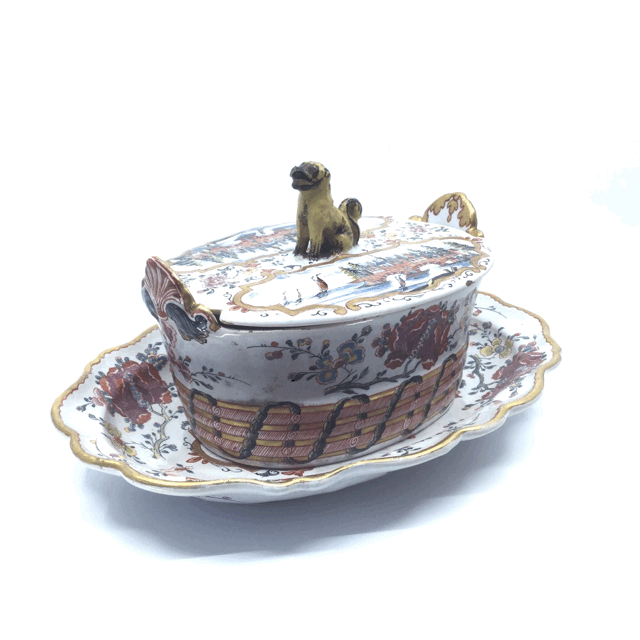
[popup_trigger id=”13756″ tag=”span”]![]() [/popup_trigger]
[/popup_trigger]
Images on this website are licensed under a
Creative Commons Attribution-NoDerivs 3.0 Unported License.

OBJECT
D2177. Pair of Petit Feu Butter Tubs, Covers and Stands
Delft, circa 1740
Unidentified VA mark in blue
After a Meissen example, each oval tureen with two shell-shaped tab handles, the lightly ribbed lower body entwined with a green foliate garland and painted on either side with flowering peonies repeated on the gilt-edged scalloped oval stand around a gilt-edged central cartouche of sailboats near turreted buildings, and the cover with two similar cartouches and surmounted by a seated dog finial.
Heights: 9.4 cm. (3.7 in.); Lengths: 18.2 cm. (7.2 in.)
Provenance: Sotheby’s Amsterdam, September 19, 2000, p. 169, lot 798; Dutch Private Collection
Note: In the first half of the eighteenth century the technique of petit feu firing was introduced in Delft to enable pieces to be decorated in fragile enamels, such as shades of pink and heightened in gold. The inspiration was from Meissen porcelain, initially with chinoiserie decoration, but by the 1740s the taste had turned towards scenes of fashionable European figures in landscapes in the manner of the French painter Jean-Antoine Watteau (1684-1721). This change in taste also coincided with the evolving etiquette of table arrangements and dining. In order to welcome guests to a more abundantly-laid table, the shapes and sizes of tablewares grew larger and more elaborate, reflected particularly in the evolution of form and decoration of butter tubs and tureens, the most important and impressive pieces in any service. Butter dishes were indispensable in Dutch households, where at least one meal a day was cold and based on bread and butter. According to Van Dam 2004, p. 155, no. 102, butter tubs were, like barrels, originally made from wooden staves bound together with stripped willow, and these shapes were copied in Dutch Delftware.
Similar examples: A rather similar pair of petit feu butter tubs with stands is in the Rijksmuseum, Amsterdam (inv. no. BK15313). A single petit feu butter tub of the same model, but without stand is illustrated in Lavino, p. 37, and another one is illustrated in Fourest 1980, p. 145, ill. 141.








